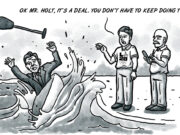
My previous post discussed the first issue of two that should inform the OKCPS school board election: making teaching a team sport. It drew upon the work of former PBS education reporter John Merrow, who wrote in 2011 that instead of focusing primarily on “making a better teacher,” America should make teaching a better job by creating cooperative school cultures. Merrow read the piece and responded with a repost of his 2011 column calling for creating a team effort to improve education.
(One reason why I support Rebecca Budd and Stanley Hupfeld is that I have seen the way both of them have reached out to people with different viewpoints. They could help transform education into a team sport.)
This second post urges the OKCPS to seek a compromise that would move us beyond our charter wars, which should seem easier to achieve compared to the call for collaborative school improvement.
Charters: From promoting innovation to encouraging competition
In the 1990s, charters were widely supported as a means for promoting innovation. As a member of the MAPS for Kids coalition, I joined the American Federation of Teachers in endorsing local charters. These charters, like magnet and enterprise schools, played a major role in persuading families to remain in the OKCPS. At that time, many families happily sent their children to OKCPS elementary schools but moved to the suburbs to avoid its secondary schools. Because charters, magnets and enterprise schools offered instruction as good as or better than low-poverty suburban schools, the OKCPS graduation rate doubled, even as overall student performance remained stagnant. (In other words, students who would have graduated anyway walked across an OKCPS stage rather than receiving a diploma on a suburban one.)
At first, it didn’t make much of a difference to high-challenge secondary schools whether it was choice or suburban schools that “creamed” the top students. After about a decade, however, OKCPS middle and high schools crossed a tipping point. For instance, in the 1990s, OKC high schools were all about 65 percent to 70 percent low-income. After the proliferation of choice crossed a certain point, OKCPS high schools were all 90 percent to 100 percent low-income.
With the No Child Left Behind Act of 2001, charters started to change from a means for innovation to a tool for competition. Charters became a win-lose proposition. Their goal was two-fold: to educate some kids better; and to outperform traditional public schools, in turn achieving a political victory over traditional public schools. Charter advocates seemed as dedicated to defeating neighborhood schools as they were to helping their own students. Worse, test scores became the ammunition for an unfair battle between charters, which wouldn’t retain students who make it more difficult to raise test scores, and neighborhood schools. It was the combination of test-driven reform and a culture of competition stacked against neighborhood schools that inflicted so much damage to the OKCPS.
Damage to secondary schools has increased
Over the last eight years, the damage done by charters to secondary schools has increased. Vitriol has also poured down on elementary students, as charters rapidly “scaled up.” The Obama administration gambled billions of dollars on a risky bet: offering incentives to charters if they would serve a larger percentage of poor children. Charters retained the extra funding but not the high-challenge kids.
Now, the OKCPS has such an oversupply of choice schools that it is it virtually impossible to expand high-performing schools without damaging other great schools by recruiting away their top teachers and students. That is why Northeast Academy has hit hard times. It was an excellent magnet and then a very good enterprise school, but, through little fault of its own, Northeast lost in competition with two equally great charters in the old Harding building.
But that is why charter expansion has become such a threat to the OKCPS. Charters can easily promise to accept more of the challenges neighborhood schools face, but holding them accountable for honoring those promises is harder. Had Budd not done an extraordinary job of documenting the differences between what some charters claim to do and what they actually accomplish, hundreds of our most vulnerable elementary students could have been pushed out of their neighborhood schools.
Hupfeld’s enterprise proposal offers hope
Perhaps that heedless attempt to expand charters is history. Board-chair candidate Hupfeld has a two-part proposal for ending our charter wars: He would only support charters — like the Hupfeld Academy — that serve an entire attendance zone, and he would expand enterprise schools. While I support Hupfeld’s call for charters that serve entire high-poverty neighborhoods, I doubt we will find any that will accept such a challenge. My main hope rests in his enterprise proposal.
Charter schools are essentially one-school districts that are free to set their own regulations as long as they obey state and federal laws. Meanwhile, enterprise schools are unionized, district schools that have their own boards and “thin” contracts granting them additional autonomy. Enterprise schools also provide site-based management. Because they are a part of the OKCPS, accountability is much more feasible. Enterprise schools offer the best of charters without opening the door to their dangers.
Enterprise schools have typically focused on academic excellence. Even though they have been extremely successful in meeting that goal, they have been just as selective as charter and magnet schools. The OKCPS should now challenge our best administrators and teachers to use the enterprise schools’ flexibility to create equal excellence for our poorest children.
I would create clusters of enterprise schools dedicated to transforming our lowest-performing schools. Because they would team up to serve an entire region, a common culture of inclusion (backed by a realistic accountability system) would deter the pushing out of students in order to jack up test scores. The cluster would be empowered to recruit educators who share a common vision for children who face the greatest challenges. Teachers would retain their due process rights, meaning that good teachers who have a different instructional approach would not lose their jobs, but principals would have the power to assemble a team dedicated to overcoming the worst poverty in the city.
Enterprise schools could represent the beginning of the end of our charter wars. On one hand, they would provide a put-up-or-shut-up moment for choice supporters. If charter advocates really want to serve all of our kids, they should accept the enterprise school challenge.
But that’s not the point.
Enterprise schools could be tip of the spear
The point is that enterprise schools should be repurposed to be the tip of the spear in the battle for equity and equal outcomes for all. They could employ a cadre of the best educators who welcome the greatest challenge in education. They would have the flexibility necessary for the common effort, the innovation and collaborative problem-solving that it takes to turn around our toughest schools. In return for increased professional autonomy, enterprise teachers would commit to serving all kids as opposed to defeating adult opponents.
By restoring the MAPS for Kids promise of site-based management, enterprise schools could reinvigorate school improvement based on the principle that MAPS espoused: You are not the problem, I am not the problem, the problem is the problem.





















